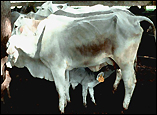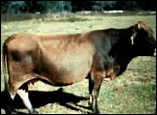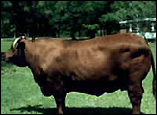- Return to Article Of The Month index
Utilize Body Condition Scoring to Improve Beef Cow Productivity
December 1999
Dr. John Arthington - Range Cattle Research & Education Center, Associate Professor of Animal Sciences
Over the next several months the majority of south Florida producers will begin their breeding season. Accordingly, this is the time of year when we pay for the results of poor cow body condition. Therefore, this brings about a good time to readdress the importance of cow body condition and body condition scoring systems in beef cow productivity.
Cow body condition scoring is the most widely described management tool for improving conception rates. The utilization of cow body condition scoring (BCS) provides a means by which producers may assess the effectiveness of a current nutrition / management program. This can be done with a limited understanding of cow nutritional requirements. The most widely used system for scoring cow body condition uses a range from 1 to 9. The use of this system provides a simple and rapid method of classifying the degree of fatness of a cow. Cows with a BCS of 1 are extremely thin, whereas cows with a BCS of 9 are extremely obese. A BCS of 5 describes a cow with moderate body condition. She should neither look fat or thin. Identifying and becoming comfortable with the visual appearance of a BCS of 5 will aid the producer in establishing a standard criterion for which to compare other cows.
Examples of Body Condition Scores 1, 5, and 9



BCS 1 (Emaciated) BCS 5 (Moderate) BCS 9 (Obese)
Cow body condition scoring is directly related to reproductive performance. Not only has this been shown throughout the country and in many different production environments, but this relationship also holds true in Florida. A summary of data by Dr. Owen Rae of the University of Florida (1993) found that cows within the herd with a BCS³ 5 had a 29% greater pregnancy rate than cows with a BCS £ 4.
One of the first improvements to be made was the introduction of Hemarthria and Florakirk on part of the acreage for hay production. Previously, bahiagrass had been used for hay. Today bahiagrass remains the predominant grass for permanent pastures. Both Linda and Hollis fee that bahiagrass meets the forage needs of their cattle better than some of the newer varieties because of the lower fertilization requirements as well as its drought resistance. Part of the better pastures are fertilized and the bahia seed is harvested in late summer. Mole crickets have been a minor problem on approximately 100 acres.
The ranch is managed in cow herds of approximately 200 cows which are rotationally grazed throughout the season. On a normal year, haying would begin in December and continue until April. The last two years have been easy winters and very little hay has been put out. Liquid feed is supplemented to replacement heifers and bulls during the winter. Block salt and mineral is provided year round.
Figure 1. Relationship of parity and BCS to pregnancy rate, %
| Parity | Body Condition Scorea | |||
| £ 3 | 4 | ³ 5 | All | |
| 1 | 20 | 53 | 90 | 84 |
| 2 | 28 | 50 | 84 | 71 |
| 3 | 23 | 60 | 90 | 85 |
| 4 – 7 | 48 | 72 | 92 | 87 |
| ³ 8 | 37 | 67 | 89 | 74 |
| All | 31 | 60 | 89 | 82 |
aBody condition scored at pregnancy testing; 1 to 9 scale, 5 = moderate
Clearly, the maintenance of body condition is important to the profitability of a cowherd. Poor cow BCS affects not only pregnancy rate, but also calving interval, calf age at weaning, and calf daily gain. In an economics summary provided by Dr. Bill Kunkle (Univ. of Florida Cooperative Extension Service, SP-144), income per cow was reduced by $107 when BCS decreased from 5 to 4, and $80 when BCS fell from 4 to 3.
When to Score?
Body condition scoring is usually best accomplished at weaning. Some producers may wish to score cows during pregnancy detection. Remember, when scoring pregnant cows, it is important to consider the contribution of the fetus. In doing so, attempt to not evaluate "gut-fill" but establish a pattern for evaluating fat cover especially over the tail-head, back, ribs, and brisket.
From calving to weaning most cows will loose body condition. This is normal and a standard sign of productivity. Therefore, producers have only a short time to reestablish body condition prior to calving and the breeding season. In south Florida, where most calves are weaned in late summer, this period of time offers challenges in environment, insects and parasites, and forage quality. Often it is essential that cows be supplemented shortly after weaning. These decisions should be made following a careful assessment of forage quality, availability, and current cow condition.
Is It Too Late?
If you find yourself entering the calving season with cows in poor body condition, you are probably too late to effectively or economically improve body condition. As the cow enters back into full lactation her energy requirements reach a peak. This is a very difficult and inefficient time to improve body condition. The best time to address improvements in cow body condition is just prior to and immediately after weaning.
Which Cows Are at Risk?
Heifers and young cows are the most susceptible to reproductive failure due to poor body condition. This group of females must not only fuel the energy requirements of reproduction and lactation, but they must also utilize a portion of their nutrient intake to fuel their own growth and body maintenance. In the priority of nutrient demands, cattle will always maintain their own bodily needs prior to addressing reproductive function. Therefore, it is not surprising that heifers and young cows make up the majority of females in the list of non-pregnant or "opens" each year.
How to Improve Body Condition?
Basically there are three management options for addressing the reproductive impact of poor cow body condition.
- Segregate and Supplement: Identify and isolate those females which have a BCS 5. Once these females are identified, they may be supplemented to a higher degree versus the more mature, higher conditioned cows. Usually, these females will represent the first-calf heifers and younger cows in the herd. Seldom is it economically feasible to utilize the same supplementation strategy across the entire herd. By identifying the females of higher nutrient need, a producer can optimize the economics of their supplementation program. Also remember that heifers and young cows respond better to supplements containing natural protein versus non-protein nitrogen (e.g. Urea). Utilize your urea containing supplements in the mature cowherd while allowing natural protein supplementation for the young females.
- Early-Weaning: The key to improving body condition lies in addressing one of two issues, 1) increase the energy intake by providing supplemental nutrition, or 2) decrease the energy demands on the female. Although in some extreme cases both 1 and 2 may need to be addressed, usually they are independent options for the producer. If increased supplementation is not an option, either because of economics or management constraints, producers may chose to early-wean their calves. Early weaning decreases the nutrient demands placed on the cow through lactation. Early weaning would have to occur at a sufficient date prior to calving and rebreeding to allow ample time for the female to improve body condition. The care of these early-weaned calves are often a challenge, however, the economics of improved reproductive performance may outweigh this management struggle.
- Low Input Systems: Some producers do not find it economically sensible to utilize either of these management options. This certainly does not mean that their system cannot be profitable. Low-input cattle production systems have existed successfully in south Florida for many years. When cattle were reared on primarily native range, it was normal for cows to wean a calf only once every two years. Cow body condition would become so poor during lactation that it would take another season before the cow had adequate energy reserves to support reproduction. Therefore, accepting this type of reproductive performance may be an option for some south Florida cattlemen.
In summary, the utilization of cow body condition scoring is a simple, effective tool for making management decisions regarding supplementation. Cows with BCS less than 5 have been shown to have decreased reproductive performance. Considering that feed costs account for the majority of the total cow/calf budget, addressing BCS effectively is important. Ultimately, a management program centered on the effective use of body condition scoring allows for a more efficient use of supplemental feeds resulting in a more productive and profitable cowherd.
Further Information
For more information on Body Condition Scoring along with color photos illustrating the use of this system, please see the following:
- Kunkle, W.E., R. S. Sand, and D. O. Rae. 1994. Effects of Body Condition on Productivity of Beef Cattle. University of Florida Cooperative Extension Service, Institute of Food and Agricultural Sciences. SP-144.
- Kunkle, W. E. and R. S. Sand. 1991. Effect of Body Condition on Rebreeding. University of Florida Cooperative Extension Service, Institute of Food and Agricultural Sciences. AS-51.

